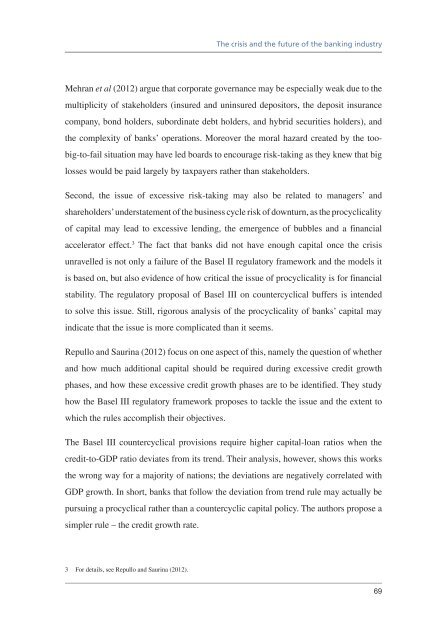Download PDF - Vox
Download PDF - Vox
Download PDF - Vox
- No tags were found...
Create successful ePaper yourself
Turn your PDF publications into a flip-book with our unique Google optimized e-Paper software.
The crisis and the future of the banking industryMehran et al (2012) argue that corporate governance may be especially weak due to themultiplicity of stakeholders (insured and uninsured depositors, the deposit insurancecompany, bond holders, subordinate debt holders, and hybrid securities holders), andthe complexity of banks’ operations. Moreover the moral hazard created by the toobig-to-failsituation may have led boards to encourage risk-taking as they knew that biglosses would be paid largely by taxpayers rather than stakeholders.Second, the issue of excessive risk-taking may also be related to managers’ andshareholders’ understatement of the business cycle risk of downturn, as the procyclicalityof capital may lead to excessive lending, the emergence of bubbles and a financialaccelerator effect. 3 The fact that banks did not have enough capital once the crisisunravelled is not only a failure of the Basel II regulatory framework and the models itis based on, but also evidence of how critical the issue of procyclicality is for financialstability. The regulatory proposal of Basel III on countercyclical buffers is intendedto solve this issue. Still, rigorous analysis of the procyclicality of banks’ capital mayindicate that the issue is more complicated than it seems.Repullo and Saurina (2012) focus on one aspect of this, namely the question of whetherand how much additional capital should be required during excessive credit growthphases, and how these excessive credit growth phases are to be identified. They studyhow the Basel III regulatory framework proposes to tackle the issue and the extent towhich the rules accomplish their objectives.The Basel III countercyclical provisions require higher capital-loan ratios when thecredit-to-GDP ratio deviates from its trend. Their analysis, however, shows this worksthe wrong way for a majority of nations; the deviations are negatively correlated withGDP growth. In short, banks that follow the deviation from trend rule may actually bepursuing a procyclical rather than a countercyclic capital policy. The authors propose asimpler rule – the credit growth rate.3 For details, see Repullo and Saurina (2012).69














